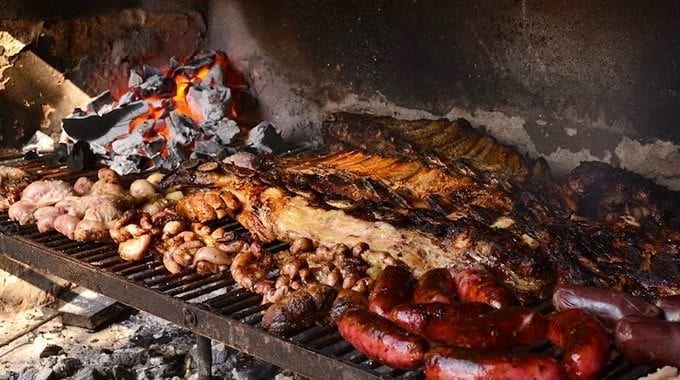Living like a local in Argentina requires a few things. Copious mate and red wine consumption, a religious affiliation to a fútbol team, contradictory behaviors, the ability to no longer require sleep, and a slang derived dialect, to name a few. However, one of the best, and maybe most quintessential Argentine event, is the asado. This involves many of the topics listed above in conjunction with a mountain of beef cooked in a parrilla (bbq grill). While in Buenos Aires all of your fellow extranjeros (foreigners) will give you their ‘expert’ opinion on which restaurant or parrilla has the best steak. What you should do is politely agree with them and tell them you’ll definitely check it out and then go to have a DIY home-made asado instead.
The asado is the ultimate social dining experience. An average one that we have consists of 7-10 people and almost an entire cow. The cooking process is long and orderly. First the coals must be prepared, which is at least an hour long process with intricate fanning patterns and scrupulous placement of the coals. Once the flame has died out and just the heat remains, the coals are scattered within the parrilla. The prepared meat and vegetables are added in a certain orientation and one person takes control of cooking all the meat, the asador, (a perk of being an obvious extranjero is that I get to observe) while other people make drinks and salivate. Our parrilla is small so the meat will come out in waves. First something small and rich and then the larger cuts later. This means that the asador can be cooking for up to two and a half hours (hence why I’ll eagerly don the ignorant gringo card). It is the equivalent of a BBQ but happens much more spontaneously and often. Last week, for example, we had three asados, all lasting over four hours long. We had to inject some vegetables into the mix for the sake of variety and so we didn’t die from over consumption of red meat.
Everyone like to know what they are eating, and here in Argentina they eat all the parts of the cow so knowing the names of the cuts could mean the difference between eating sirloin and cow groin. I have tried to learn the names of all the different parts of the cow but still get them all mixed up.
Here are the common cuts of beef consumed at a typical Argentine asado:
Ojo de Bife: Ribeye steak. Amazing.
Bife de Lomo: Tenderloin. Extremely tender, less flavor than the ojo de bife.
Entraña: Skirt steak. Known for its great flavor but can be chewy.
Vacio: Flank steak. Cut from the abdominal muscles of the cow. Good flavor but chewy.
Bife Angosto: Porterhouse/T-Bone.
Chorizo: Sausage but not spicy. Regardless, incredible flavor.
Morcilla: Blood sausage. Rare in other parts of the world but easy to find here.
Bife de Chorizo: Sirloin. One of the best cuts that you can get!
Mollejas: Sweetbreads. Thymus of the cow. Eaten with salt and lemon juice and very tasty.
How do you want your meat cooked?
Bleu: Vuelta y vuelta (outsides cooked very fast, inside completely rare)
Rare: Bien jugoso
Medium-rare: Jugoso
Medium: A punto
Well-done: Cocido
Note: Majority of the Argentines prefer their meat to be more on the cooked side. A punto and cocido are the norm. If you don’t specify, those are usually what they will serve you.
You have undoubtedly heard that Argentina is famous for its meat. Of all the things that may be over elaborated the meat here is not one of them. I will miss the quality and price when I go home; so during your stay let loose and enjoy the amazing steak that is so archetypal of Argentina.
Alex




